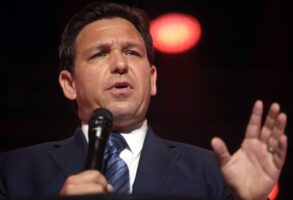
Published March 30, 2018
National Review - April 2, 2018 issue
This year’s Conservative Political Action Conference was controversial. Invitations to European nationalist populists such as Nigel Farage and Marion Maréchal-Le Pen (the niece of Marine Le Pen) caused many longtime conservatives to question whether they still belong to the conservative movement. Vocal critics of President Trump have blamed him for CPAC’s shift away from the themes and speakers traditionally favored by movement types. The truth, however, is that Trump is less a cause and more a symptom of a change that had already taken place.
Immigration and trade are two excellent examples of this. In the halcyon days of yore, movement conservatives were thought to be staunchly pro-immigration and pro–free trade. President Reagan and both Presidents Bush backed these views (although they also imposed retaliatory tariffs from time to time). The nationalist-populist speakers so prominently on display at CPAC distinctly do not share these views. But they are not wholly out of step with conservative or Republican-party sentiment.
The 2012 and 2016 exit polls clearly show that Trump’s ascendance did not significantly shift Republican views on immigration. In the 2016 exit polls, 47 percent of Trump’s backers favored the deportation of illegal immigrants. But 43 percent of Romney’s voters said the same thing in the 2012 exit polls. Support for less drastic approaches to immigration, such as building “the wall,” have much higher levels of support. Nearly 80 percent of Trump’s backers supported this in the 2016 exit polls. Given the numbers on the deportation question, one doubts that support for the wall would have been much lower had pollsters asked the question in 2012. Conservatives are no longer, if they ever were, staunchly pro-immigration.
Backers of untrammeled free trade are also out of step with conservatives. Data from Pew Research Center polls in 2017 show that over 65 percent of Republicans think that free-trade agreements have been bad for America. The 2016 exit polls show that 42 percent of Americans think international trade has cost America jobs. These voters backed Trump by more than two to one, and they account for more than 60 percent of his support.
Trump’s conservative critics also might be surprised at other places where they differ with majority sentiment. Many of those who no longer feel comfortable within the movement vociferously oppose the president’s travel ban or its prior campaign iteration, a complete ban on Muslim immigration. Yet Cato’s Emily Ekins found that support for the Muslim ban was the only significant issue that all types of Trump general-election voters shared. Exit-poll data from the 2016 primaries also show that support for the proposed Muslim ban united Trump backers more than any other issue, including immigration. The most educationally and financially upscale voter groups backing Trump were the least favorable to it, but they made up only about a quarter of Trump’s support.
Older movement conservatives must also come to grips with the wavering support for — and lessening priority given to — shrinking government. While most partisan Republicans continue to support the idea of a smaller government, increasingly they prioritize issues such as tax reform or fighting the spread of cultural progressivism. And many of the new voters Trump attracted, those who had voted for Obama and other Democrats in years past, don’t care much about shrinking government at all.
We can see the reduced priority that conservative Republicans place on cutting government by looking carefully at how they have voted in prior presidential primaries. University of New Hampshire political scientist Dante Scala and I examined exit-poll data from the Republican presidential primaries from 2000 through 2012 in our book The Four Faces of the Republican Party. We found that fiscal conservatives — people who both favored shrinking government and prioritized it in their voting — made up somewhere between a tenth and a sixth of GOP-primary voters. Social conservatives were over twice as numerous, and even if they supported fiscal-conservative goals, they made social issues — abortion bans, religious liberty, and so forth — their voting priority. That simple fact explains why fiscal-conservative favorites such as Steve Forbes and Fred Thompson failed to catch fire, while religious-conservative leaders such as Mike Huckabee and Rick Santorum did.
Even fiscal conservatives, however, don’t prioritize small government as they used to. As far back as 1996, the change was obvious to anyone who wanted to see. Texas senator Phil Gramm ran for the GOP nomination as the small-government favorite. He had favored tax cuts during his time in the House and Senate, but he was best known for wanting to cut government. His name was on President Reagan’s budget-cutting bill that passed in 1981 (Gramm-Latta), and he was a co-author of the leading spending-control bill during the 1980s, the Gramm-Rudman-Hollings Act. If cutting government was a movement priority, he should easily have been a strong contender for the presidency.
Instead, his candidacy never made it out of Iowa. Pat Buchanan shocked the political world by beating him in Louisiana’s very early caucuses and again trounced him in Iowa. In both states, Buchanan rallied social conservatives to his cause, showing that the religious element of the movement preferred social conservatism even when it was allied, as it was in Buchanan’s case, with a proto-economic-nationalist agenda. In Iowa, flat-tax enthusiast Steve Forbes also trounced Gramm. It turns out that fiscal conservatives were much more excited by cutting taxes than they were by cutting spending.
If the voter base of the conservative movement no longer supports the small-government, open-to-the-world policies that so many leading Trump critics back, what are the criticsto do? More important, what should be the movement’s response to this dissatisfaction? Should Trump critics still be welcome within movement walls?
The small-government, globally minded Trump critic has three choices. First, he or she can support a primary challenge to President Trump in 2020. This is doomed to failure, however, because these critics are such a small, albeit influential and vocal, part of the broader party. They might not perceive this limitation because so many of them live in and around Washington, D.C. But consider this: Only three cities or counties in the entire country gave Marco Rubio and John Kasich over 70 percent of the vote in the 2016 primaries: Washington, D.C.; and two inner suburbs in Virginia, Arlington and Alexandria. The Trump critics’ circle of friends in the D.C. area is very unlike the national party or movement.
Their second choice is to start a new party, as Juleanna Glover suggested in a recent New York Times piece. This idea suffers, however, from the same problem as the primary challenge. There simply aren’t enough dissatisfied conservatives to form a viable party. Joining with the Libertarian party won’t add much to their numbers, as partisan libertarians are no more than 1 percent of the total electorate. To gain viability, they would therefore have to join with dissatisfied moderate independents and moderate liberals who are upset at the Democratic party’s swerve leftward. That combination could gain enough support to win elections, but the conservative part of this grouping would have to compromise a lot to make the new union coherent. The party’s economic platform would look a lot more like Simpson-Bowles than the return of Ronald Reagan.
That leaves Trump’s conservative critics with a third choice: work within the current conservative movement to maximize their influence on the GOP. That will force the critics to sort out their own priorities. If they care more about immigration and trade than they do about defense policy or tax cuts, their influence will probably wane. But if they are willing to work with other conservative-movement types on immigration and trade to reach common ground, they might find that other longtime conservatives are willing to work with them.
This makes the attitude of movement leaders crucial to the movement’s continued development. For all the bluster and boisterous behavior one finds in Trump-friendly circles, Trump fans do not represent a majority of Americans. Trump lost the popular vote, and one big reason was that a significant number of Trump-critic conservatives voted for Gary Johnson, Evan McMullin, or a write-in. Re-attracting these critics would increase the power of the Trump-dominated GOP. But to win them back, the pro-Trump portion of the party must listen to their dislike of tariffs and of racially charged language, and note their preference for a higher-toned, more optimistic view of America and her future.
Both the movement and its conservative critics face what Reagan called a time for choosing. Do we choose to see that we have more in common than we do not? Do we choose to work out those differences in a spirit of unity rather than one of division? Or do we instead choose to maintain our purity and, as Reagan said of purists, “jump off the cliff with flags flying”?
The conservative movement has never been a uniform, doctrinaire group. Frank Meyer’s fusionism ensured for its time that social conservatives, libertarian conservatives, traditionalists, and defense conservatives could all coexist — if at times uneasily — in the same political home. Our task is to renew that fusionism for today, to renew the conservative movement so that it continues to provide political guidance for a nation that sorely needs it. If not us, who? If not now, when?
— Mr. Olsen is a senior fellow at the Ethics and Public Policy Center, an editor at UnHerd.com, and the author of The Working Class Republican: Ronald Reagan and the Return of Blue-Collar Conservatism.








